| | Extreme Temperature Diary- Wednesday October 21st, 2025/Main Topic: Climate Central Restarts U.S. Billion-Dollar Weather and Climate Disasters Database – Guy On Climate
Dear Diary. The Trump Administration in its infinite wisdom (not!) decided to keep NOAA from keeping tabs on billion-dollar disasters early this year. Yes, they think that if people see and read no evil that the public won’t be aware of big climate change related disasters. The Trump Administration is making every effort from getting increasing occurrences of billion-dollar disasters blamed on our burning of fossil fuels. So, it has been up to private entities to keep tabs on our climate expense tab.
Thankfully, after a few months of darkness, Climate Central has been able to turn the lights back on. Here is their release concerning how they are administering and distributing billion-dollar disaster information:
📣 The "U.S. Billion-Dollar Weather and Climate Disasters" data is back today through @climatecentral.org! And more soon!
➡️ Explore our new interactive website at www.climatecentral.org/climate-serv..., which is now updated through the first half of 2025 & totaling over $101 billion from 14 events. — Zack Labe (@zacklabe.com) 2025-10-22T14:03:53.961Z
#ClimateCrisis: The billion dollar disaster list “has been one of the most effective bridges to the public communicating the increasing costs of disasters” NOAA Isn't Tracking Disaster Damanges Anymore, so Who Is?
www.nytimes.com/2025/10/22/c... — Silicon Valley North - Citizens Climate Lobby (@cclsvn.bsky.social) 2025-10-22T14:20:44.361Z
Now at Climate Central: U.S. Billion-Dollar Weather and Climate Disasters | Climate Central
Climate Matters•October 22, 2025
Now at Climate Central: U.S. Billion-Dollar Weather and Climate DisastersNow at Climate Central: U.S. Billion-Dollar Weather and Climate Disasters Click the downloadable graphic: Billion-Dollar Disasters January – June 2025
Click the downloadable graphic: Billion-Dollar Disasters 1980 – June 2025
Click the downloadable video: U.S. Billion-Dollar Weather and Climate Disasters: Shel Winkley, Meteorologist
KEY FACTS- The U.S. Billion-Dollar Weather and Climate Disasters database has a new home at Climate Central, with the latest available data through June 2025.
- Climate Central is restarting and sustaining this publicly accessible resource at a time when the frequency and costs of these devastating events have risen to unprecedented levels.
- The future of this database was uncertain after NOAA ceased operations of the project in May 2025.
- During the first six months of 2025, there have been 14 separate billion-dollar weather and climate disasters in the U.S., costing $101.4 billion.
- The Los Angeles wildfires in January 2025 were the costliest event so far this year as well as the costliest wildfire event on record — exceeding $60 billion, or about twice as much as the previous record.
- With 14 events already this year, 2025 is well above the long-term annual average of nine events per year.
Explore the database Click to download this ready-to-air video, Hail Chasers: Hunting America’s $10 Billion Weather Threat. This fully produced news story can be used by media outlets for broadcasts, streaming, and digital at no cost. Click here for other available packages. Click to download this ready-to-air video, Hail Chasers: Hunting America’s $10 Billion Weather Threat. This fully produced news story can be used by media outlets for broadcasts, streaming, and digital at no cost. Click here for other available packages.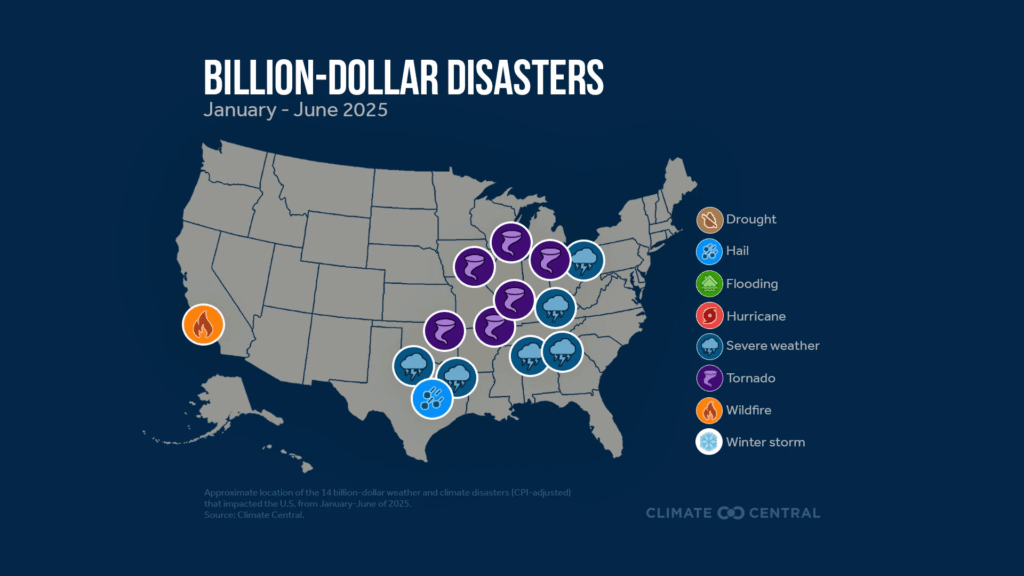 Climate Central’s new billion-dollar disasters databaseThe U.S. Billion-Dollar Weather and Climate Disasters database has a new home at Climate Central. Climate Central’s new billion-dollar disasters databaseThe U.S. Billion-Dollar Weather and Climate Disasters database has a new home at Climate Central.
The future of this database of the most costly U.S. weather and climate disasters was uncertain after the National Oceanic and Atmospheric Administration (NOAA) ceased project operations in May 2025.
This data has been used for decades to inform the public, conduct research, insure homes and businesses at risk, and increase communities’ resilience during a period of rising risk.
On October 22, Climate Central launched the new U.S. Billion-Dollar Weather and Climate Disasters database with the latest data (though June 2025) and the full archive (starting in 1980).
Climate Central is restarting and sustaining this publicly accessible resource at a time when the frequency and costs of these devastating events have risen to unprecedented levels.
The peer-reviewed methodologies behind this dataset remain unchanged at Climate Central, where the project will continue to be led by Adam Smith, who served as the lead scientist for the project at NOAA for the last 15 years.
Climate Central will issue regular updates to this dataset and plans to expand upon the foundational work established by NOAA’s National Centers for Environmental Information.
In early 2026, Climate Central will release a full review of U.S. billion-dollar disasters in 2025.
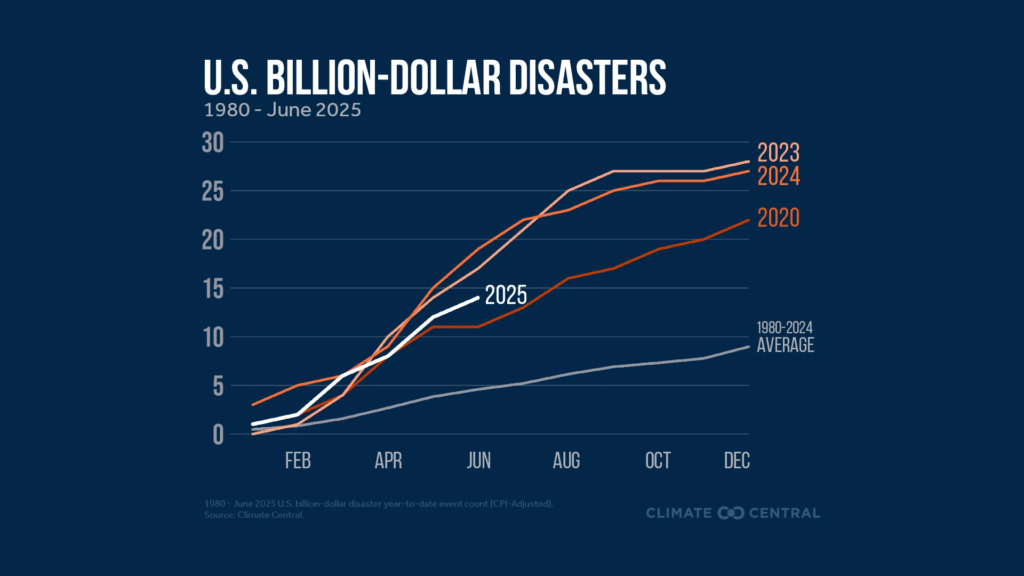 Click the downloadable graphic: Billion-Dollar Disasters 1980 – June 2025 Click the downloadable graphic: Billion-Dollar Disasters 1980 – June 2025
Billion-dollar disasters in 2025Through June 2025, the U.S. has experienced 14 separate billion-dollar weather and climate disasters this year with a total cost of $101.4 billion.
With 14 events so far this year, 2025 is well above the long-term annual average of nine events per year.
The costliest event of 2025 was also the first. The Los Angeles wildfires (January 7-28, 2025) exceeded $60 billion. This was the country’s most expensive wildfire event on record — costing nearly twice as much as the previous record wildfire event (in 2018) and making the first six months of 2025 the costliest start to any year on record.
The remaining 13 billion-dollar events so far in 2025 were all due to severe weather. The first six months of 2025 make this a top-three year for the number of billion-dollar severe storms.
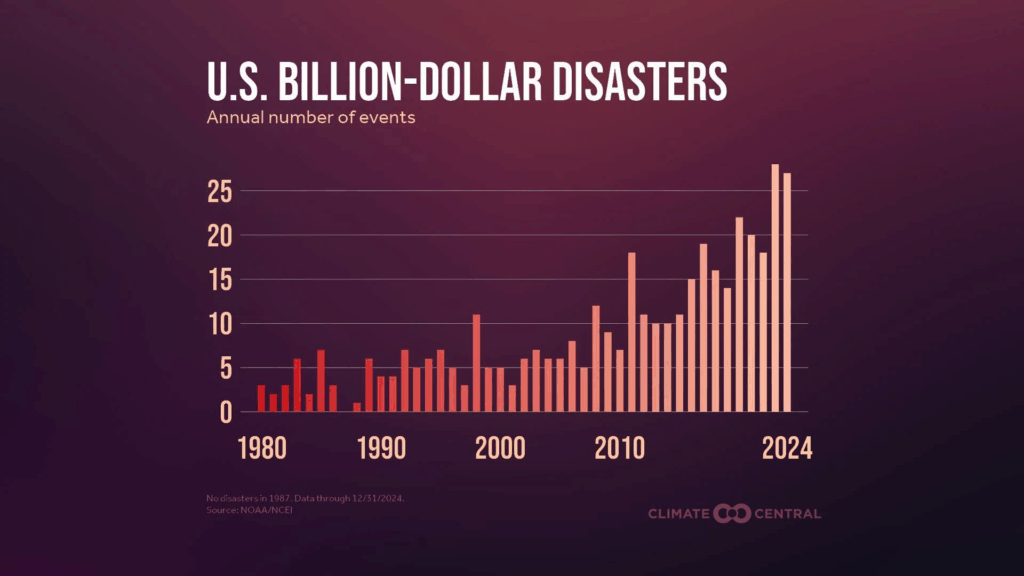 Click the downloadable graphic: U.S. Billion-Dollar Disasters Click the downloadable graphic: U.S. Billion-Dollar Disasters
More costly disasters, more oftenThe frequency of billion-dollar disasters has increased dramatically since 1980.
- The average number of billion-dollar disasters per year has grown from about three events annually during the 1980s to 19 events annually during the last 10 years.
- The last two years (2023 and 2024) shattered previous records with 28 and 27 billion-dollar disasters, respectively.
Over the same period, the direct costs of billion-dollar disasters have surged.
Average annual inflation-adjusted costs more than quadrupled from the 1980s ($22.6 billion per year) to the 2010s ($102.0 billion per year).
- Costs continued to rise, reaching an average of $153.2 billion per year during 2020-2024 — a 50% increase over the 2010s.
These trends reflect both the rising frequency and intensity of extreme weather and the growing number of people, homes, and businesses exposed to these hazards. Accelerated development in fire-prone areas, along coasts, and in floodplains can multiply the damage from extreme events.
Related Resources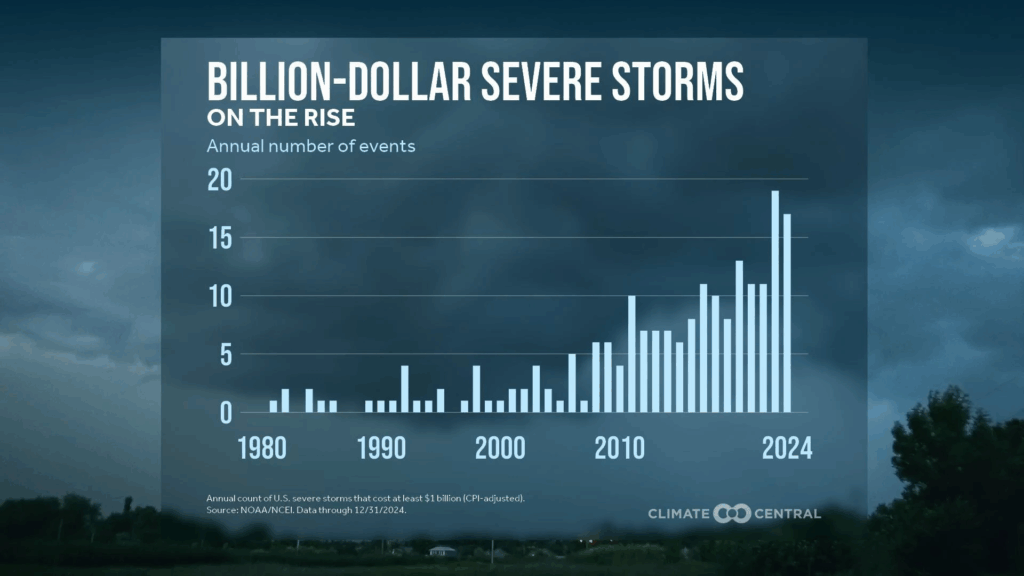 https://www.climatecentral.org/toolkit-severe-weather https://www.climatecentral.org/toolkit-severe-weather
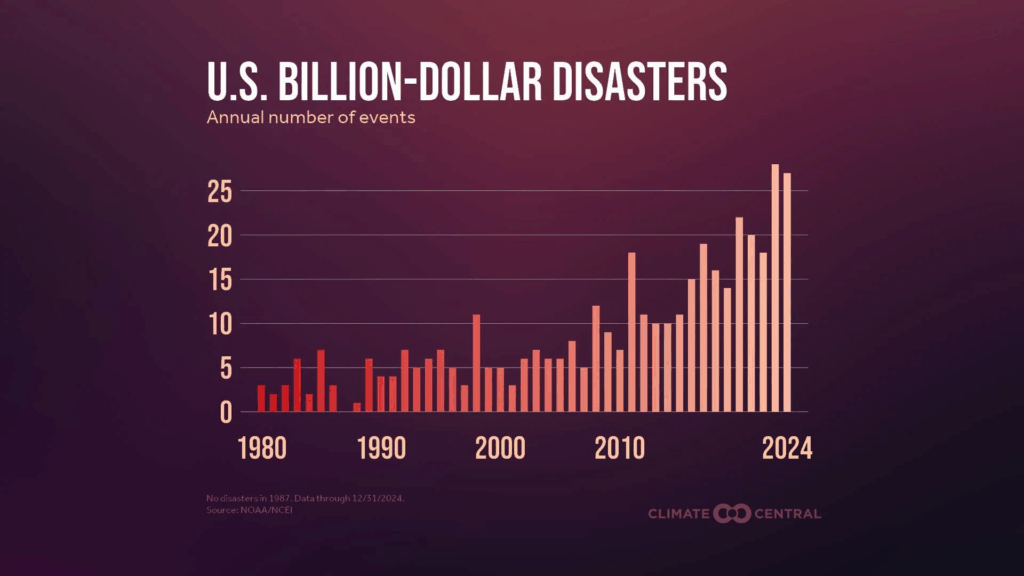 https://www.climatecentral.org/climate-matters/billion-dollar-disasters-2025 https://www.climatecentral.org/climate-matters/billion-dollar-disasters-2025
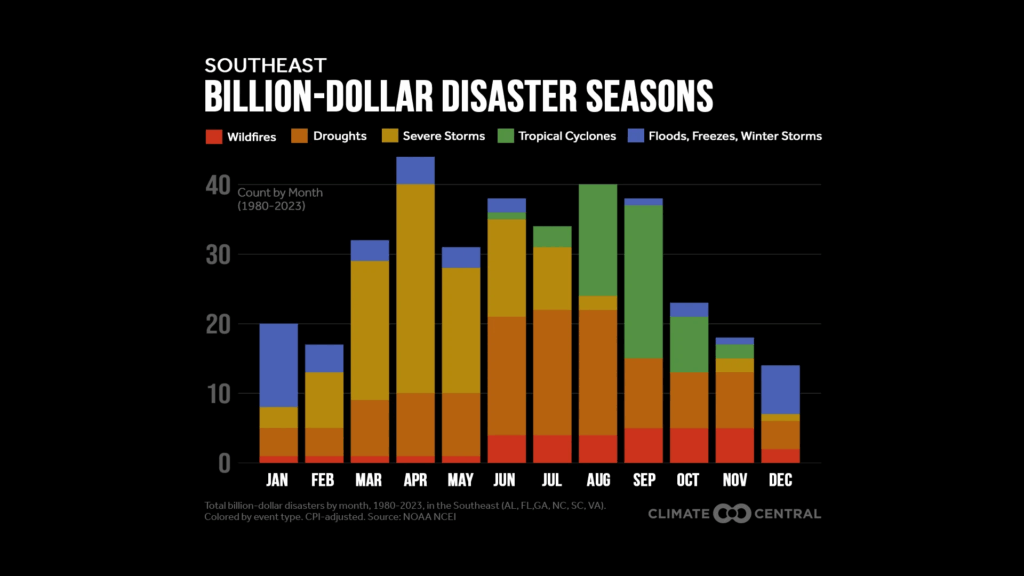 https://www.climatecentral.org/climate-matters/billion-dollar-disaster-seasons-2024 https://www.climatecentral.org/climate-matters/billion-dollar-disaster-seasons-2024
LOCAL STORY ANGLESReporting on extreme weather events and disasters near you:For more information on billion-dollar disasters, explore Climate Central’s new database including an events overview, summary statistics, interactive charts and maps of archived data (since 1980), and summaries of all 417 events on record.
Climate Central’s Extreme Weather Toolkits provide quick facts and reporting resources on the links between climate change and tropical cyclones, severe storms, heavy rainfall and flooding, wildfire, extreme heat, and more.
Local and state emergency managers, agricultural departments, and insurance data, can give an early sense of the damage and who is affected after extreme weather events. USDA crop reports, state climatologists, and regional climate centers can also help put an event into context.
What hazard mitigation or adaptation measures are happening in your local area?The U.S. Climate Resilience Toolkit provides links to numerous government agencies, tools for assessing hazards, and case studies of adaptation and resilience efforts around the country. Climate Mapping for Resilience and Adaptation integrates information from across the federal government to help communities assess and plan for climate-related hazards in their area.
Local officials and state emergency management agencies can provide information about official disaster planning, emergency response, and available state-funded and federal disaster assistance programs. The Society for Environmental Journalism has compiled disaster resilience resources to support local reporting.
CONTACT EXPERTSTo request an interview with a Climate Central scientist about this analysis, please contact Abbie Veitch, aveitch@climatecentral.org.
FIND EXPERTSSubmit a request to SciLine from the American Association for the Advancement of Science or to the Climate Data Concierge from Columbia University. These free services rapidly connect journalists to relevant scientific experts.
Browse maps of climate experts and services at regional NOAA, USDA, and Department of the Interior offices.
Explore databases such as 500 Women Scientists, BIPOC Climate and Energy Justice PhDs, and Diverse Sources to find and amplify diverse expert voices.
Reach out to your State Climate Office or the nearest Land-Grant University to connect with scientists, educators, and extension staff in your local area.
METHODOLOGYAll billion-dollar disaster cost estimates included in this Climate Matters are adjusted for inflation (CPI-adjusted). For a full methodology: climatecentral.org.
U.S. billion-dollar disaster data and analysis for 2025 (including CPI-adjustments) reflects the latest available data through June 2025.
HISTORIC HEAT IN AUSTRALIA
Insane Minimum 30.1 Brewon
NEW SOUTH WALES HOTTEST OCTOBER NIGHT EVER
Dozens of records smashed by even 4/5C(see below)
Yesterday incredible 44.9 in New South Wales
It's one of the top most extreme events Australia has ever experienced
Map compiled 100% by Cameron H (X) — Extreme Temperatures Around the World (@extremetemps.bsky.social) 2025-10-22T14:12:00.297Z
China experienced a sudden shift in temperature! On October 21st, 6 stations, and on October 22nd, 14 stations broke their the lowest October Tmax records! Guangzhou, Shenzhen, and Hong Kong dipped below 18C, reaching their lowest point in six months — Extreme Temperatures Around the World (@extremetemps.bsky.social) 2025-10-22T14:17:48.793Z
Record heat continues in BANGLADESH & MYANMAR
36.5 at Feni, record again
In MYANMAR October hottest day at Kyeikkhame with 36.3C
Nearly Every single tropical country is breaking records. Unprecedented. — Extreme Temperatures Around the World (@extremetemps.bsky.social) 2025-10-22T15:58:08.387Z
Record hot nights continue unabated in SE Asia,
Minimums still >28C in the Spratly Islands (Vietnam) and Philippines (Cuyo and Roxas)!
Calapan broke again its record of October hottest night with a minimum of 26.6C. — Extreme Temperatures Around the World (@extremetemps.bsky.social) 2025-10-22T07:47:18.432Z
EXCEPTIONAL HEAT IN TANZANIA
Insane Minimums +23/+24C on the highlands above 800m/1200m.
Hottest night in history for Tambora and Kigoma with minimums of 23.6C and 23.7C.
Records keep falling in 100% of the Tropics. — Extreme Temperatures Around the World (@extremetemps.bsky.social) 2025-10-22T10:59:45.014Z
Global use of #coal hit record high in 2024
Bleak report finds greenhouse gas emissions are still rising despite ‘exponential’ growth of #renewables.
#climate
www.theguardian.com/environment/... — Dr Paul Dorfman (@drpauldorfman.bsky.social) 2025-10-22T07:41:26.772Z
Death cult finance institutions.
No major banks have yet committed to stop funding new oil, gas and coal.
#climate
www.theguardian.com/environment/... — Dr Paul Dorfman (@drpauldorfman.bsky.social) 2025-10-22T07:35:36.008Z
“It’s the first tropical forest of its kind to show this symptom of change”
Researchers say carbon emissions change in Queensland tropical rainforests may have global climate implications
www.theguardian.com/environment/... — Silicon Valley North - Citizens Climate Lobby (@cclsvn.bsky.social) 2025-10-22T14:59:20.149Z
If you want to understand why the human race is fatally ill equipped to deal with catastrophic #climatechange (we can’t even stop buying more fuel burning vehicles & boilers🙄) this 3 minute comedy sketch brilliantly illustrates why. The death and damage just seems a long time away — David Nicholson (@rivergecko.bsky.social) 2025-09-11T11:17:06.127Z
Correction: Join us Oct 28th at 7 PM ET for a virtual discussion with Mark Jacobson on how electrifying buildings, transportation, and industries with 100% clean, renewable energy can create jobs, save lives, and stabilize our planet.
Register here: www.eldersclimateaction.org/events — Elders Climate Action (@eldersclimate.bsky.social) 2025-10-21T15:36:55.833Z
Join us Oct 23, 7 PM ET | 4 PM PT for our Congressional Postcard Project Kickoff Event. Learn how to take action by sending postcards to Congress.
Then join our 30-min training Nov 6, 7 PM ET to get started.
Register: eldersclimateaction.org/events
Join: eldersclimateaction.org/postcards — Elders Climate Action (@eldersclimate.bsky.social) 2025-10-22T12:01:04.365Z
Tropical Storm #Melissa has not yet strengthened. But this actually bad news, since a weaker storm is more likely to linger in the Caribbean and become a major hurricane, as @bhensonweather.bsky.social and I explain:
yaleclimateconnections.org/2025/10/trop... — Dr. Jeff Masters (@drjeffmasters.bsky.social) 2025-10-22T16:29:18.423Z
Big-name banks accused of providing $2bn direct financing for oil and gas extraction projects within the Amazon rainforest since January 2024, with JP Morgan Chase, Bank of America and Citi named worst offenders.
www.edie.net/big-name-ban... — Dr Paul Dorfman (@drpauldorfman.bsky.social) 2025-10-22T07:34:09.768Z
“EPA abruptly and unlawfully terminated the program and clawed back the vast majority of the money already awarded. That has left the plaintiffs without access to the funds to proceed”
pv-magazine-usa.com/2025/10/21/1... — Silicon Valley North - Citizens Climate Lobby (@cclsvn.bsky.social) 2025-10-22T14:28:00.782Z
— Dr Paul Dorfman (@drpauldorfman.bsky.social) 2025-10-22T08:04:43.125Z
— Dr Paul Dorfman (@drpauldorfman.bsky.social) 2025-10-22T08:02:22.185Z
Energy Storage Market Outlook forecasts 23% increase annual energy #storage additions in 2025, record 92GW new capacity. Global energy storage market record year, with 92GW/247GWh annual energy storage additions forecast in 2025 by BloombergNEF
www.businessgreen.com/news-analysi... — Dr Paul Dorfman (@drpauldorfman.bsky.social) 2025-10-22T07:32:30.403Z
World’s biggest industrial heat battery begins operations, powered by on-site solar array reneweconomy.com.au/worlds-bigge... — Dr Paul Dorfman (@drpauldorfman.bsky.social) 2025-10-22T07:30:28.398Z
'New generation of panels is emerging using a class of materials called perovskites, which can be thinner, lighter, less rigid and generate more power. The technology means solar panels could be integrated into new places such as car roofs, lampposts and even windows.'
www.ft.com/content/a509... — Dr Paul Dorfman (@drpauldorfman.bsky.social) 2025-10-22T07:28:08.822Z
Nearly half of #solar capacity will be co-located with storage.
www.pv-magazine.com/2025/10/21/n... — Dr Paul Dorfman (@drpauldorfman.bsky.social) 2025-10-22T07:27:12.586Z
#FossilFuels - Out-of-State pipeline planned to bolster fuel supplies.
www.mercurynews.com/2025/10/21/p... — Silicon Valley North - Citizens Climate Lobby (@cclsvn.bsky.social) 2025-10-22T14:09:01.416Z
Good grief !
'US offers #nuclear energy companies access to weapons-grade plutonium.
Expert warns commercial use of the radioactive material from cold war-era warheads carries safety risks.'
www.ft.com/content/2fbb... — Dr Paul Dorfman (@drpauldorfman.bsky.social) 2025-10-22T07:20:47.808Z
Ludicrous #nuclear bubble.
Nuclear tech corp Oklo has no revenues, no licence to operate reactors, no contracts to supply power. But this Silicon Valley start-up rides a wave of investor enthusiasm propelling its stock market valuation above $20bn.
www.ft.com/content/cdf0... — Dr Paul Dorfman (@drpauldorfman.bsky.social) 2025-10-22T07:15:00.671Z
My co-author @peterhotezmdphd.bsky.social & I discussed our new book #ScienceUnderSiege with the great @mehdirhasan.bsky.social | Full 20+ minute interview via Youtube: www.youtube.com/watch?v=Sbdt... — Michael E. Mann (@michaelemann.bsky.social) 2025-10-22T15:14:27.867Z
“Those are all ways to increase separation between vulnerable road users, bikes and pedestrians, and vehicle traffic, and that makes vulnerable road users safer” In Napa CA, an effort to safeguard #cyclists
www.mercurynews.com/2025/10/21/n... — Silicon Valley North - Citizens Climate Lobby (@cclsvn.bsky.social) 2025-10-22T14:23:50.032Z
"[A]s companies destroyed local forests to make way for plantations, rainfall in those areas decreased, which led to crop failures and lower yields and, ultimately, higher prices for consumers." #Coffee Plantations & Rainfall
www.nytimes.com/2025/10/22/w... — Silicon Valley North - Citizens Climate Lobby (@cclsvn.bsky.social) 2025-10-22T14:18:11.267Z
#Agriculture “When you throw something else on and the stress of going through the harvest, that’s just one more nail in the coffin.” Government Shutdown Adds More Challenges
civileats.com/2025/10/22/f... — Silicon Valley North - Citizens Climate Lobby (@cclsvn.bsky.social) 2025-10-22T14:37:48.857Z
|
|






 Climate Central’s new billion-dollar disasters databaseThe
Climate Central’s new billion-dollar disasters databaseThe 

 https://www.climatecentral.org/toolkit-severe-weather
https://www.climatecentral.org/toolkit-severe-weather https://www.climatecentral.org/climate-matters/billion-dollar-disasters-2025
https://www.climatecentral.org/climate-matters/billion-dollar-disasters-2025 https://www.climatecentral.org/climate-matters/billion-dollar-disaster-seasons-2024
https://www.climatecentral.org/climate-matters/billion-dollar-disaster-seasons-2024